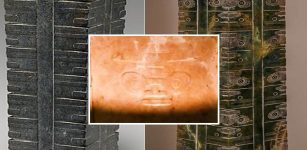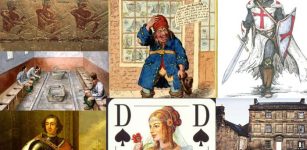Tomb Of Hathor’s Priestess Hetpet Unearthed Near Pyramid Of Khafre, Cairo, Egypt
AncientPages.com - Archaeologists report discovery of tomb that belong to the 5th Dynasty top official Hetpet who was the priestess of Hathor, an ancient Egyptian goddess who personified the principles of joy, feminine love, and motherhood.
After almost 109 years of searching, the tomb was discovered near Pyramid of Khafre on Giza Plateau, Cairo, Egypt.
“The tomb has never been uncovered until October 2017 when the Egyptian mission started excavation in the Giza western cemetery,” El-Enany said, who also added that blocks of the tomb were unearthed in 1909 by a British explorer who sent them to Berlin and Frankfurt.
The cemetery was previously excavated by several archaeological missions since 1843, and the newly discovered tomb belongs to a lady named Hetpet, a top official in the royal palace during the end of the 5th Dynasty, writes Ahram Online.
See also:
What Happened To The Staircase In The Temple Of The Goddess Hathor?
The tomb has the architectural style and decorative elements of the 5th Dynasty, with an entrance leading to an “L” shape shrine with a purification basin.

A 4000-year-old tomb of Fifth Dynasty prominent woman discovered near Pyramid of Khafre on Giza Plateau, Cairo, Egypt
On its western rear end there is a rectangular arcade lined with incense and offering holders. There is also a naos with a yet missing statue of the tomb’s owner. The tomb has very distinguished wall paintings in a very good state of conservation depicting “Hetpet” standing in different hunting and fishing scenes or sitting before a large offering table receiving offerings from her children.

A 4000-year-old tomb of Fifth Dynasty priestess - a scene depicts a monkey. Image credit: Ahram Online
Walls are covered with scenes of reaping fruits, melting metals and the fabrication of leather and papyri boats as well as musical and dancing performances. Among the most notable paintings in the tomb are those depicting two monkeys in different positions.
Monkeys were domestic animals at the time.
See also:
Nefertiti Was A Powerful Queen But Never A Pharaoh – Researcher Says
Burial Chamber Of Ankhesenamun, Tutankhamun’s Wife May Soon Be Found
The first scene shows a monkey reaping fruits while the second displays a monkey dancing in front of an orchestra. Similar scenes are found in other tombs.
The first one is painted on the wall of a 12th Dynasty tomb of Khnoum Hetep II in Beni Hassan in Minya governorate; the second is found in the Old Kingdom tomb of Ka-Iber in Saqqara, though it displays a dancing monkey in front of a guitarist not an orchestra.
AncientPages.com





















